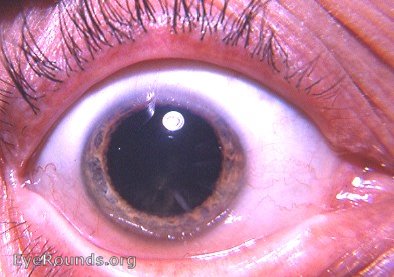EyeRounds Online Atlas of Ophthalmology
Contributor: William Charles Caccamise, Sr, MD, Retired Clinical Assistant Professor of Ophthalmology, University of Rochester School of Medicine and Dentistry
*Dr. Caccamise has very generously shared his images of patients taken while operating during the "eye season" in rural India as well as those from his private practice during the 1960's and 1970's. Many of his images are significant for their historical perspective and for techniques and conditions seen in settings in undeveloped areas.
Category: Cataract
Incipient, immature cortical cataractous changes in the inferior-nasal quadrant of the lens

In searching for cataractous changes during a routine eye exam, the ophthalmologist will have his most fruitful results if under full mydriasis he examines the inferior-nasal quadrant of the lens out to the equator of the lens. This photo with its incipient cuneiform changes is a perfect example of such cataractous changes. The remainder of the lens is clear. How to answer the patient's question: " Doctor, do I have a cataract?" can offer a dilemma. A cataract is technically any opacity in the lens. However, some ophthalmologists in dealing with patients prefer to limit the word cataract to opacities that have vision significance. The ophthalmologist must recognize that the word cataract has frightening significance to most patients. It is not a word that they want to hear during an eye examination. If lens opacities have no vision significance, the ophthalmologist should be very careful and considerate in the words that he chooses to use in discussing the matter with the patient.


Ophthalmic Atlas Images by EyeRounds.org, The University of Iowa are licensed under a Creative Commons Attribution-NonCommercial-NoDerivs 3.0 Unported License.


